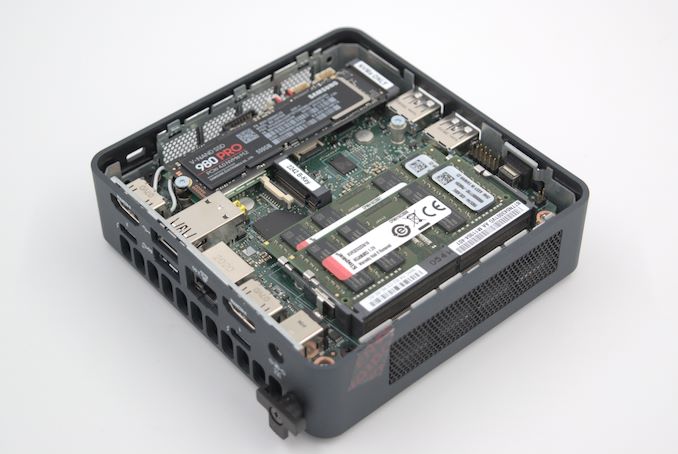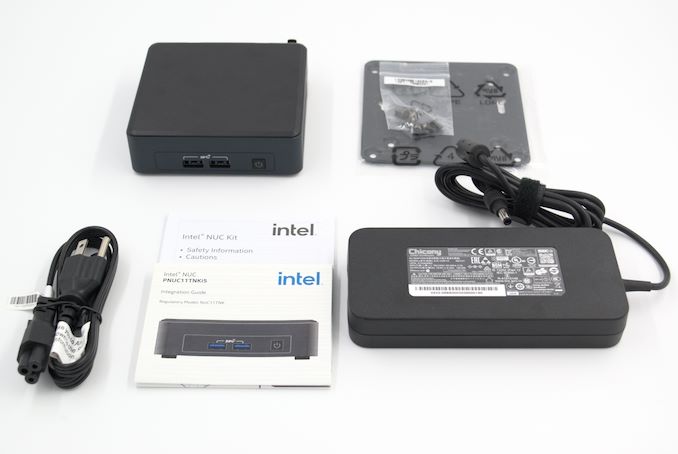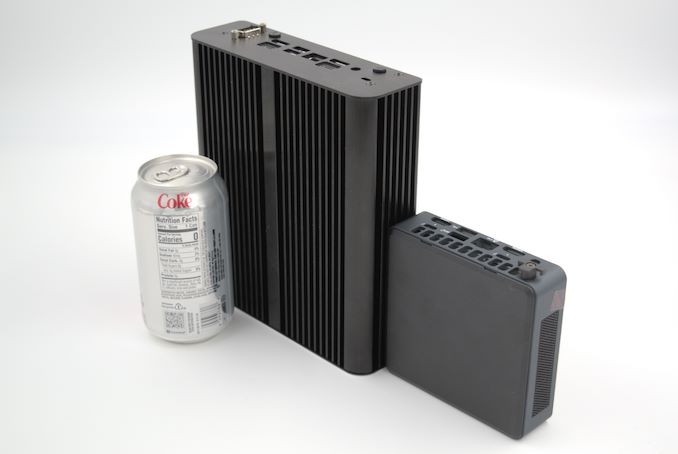Intel NUC11TNBi5 and Akasa Newton TN Fanless Case Review: Silencing the Tiger
by Ganesh T S on July 22, 2022 8:00 AM EST- Posted in
- Systems
- Intel
- Fanless
- HTPC
- NUC
- Passive Cooling
- UCFF
- Tiger Lake
- Akasa

Intel's Tiger Lake-based NUCs have been shipping for well over a year now. Four product lines were planned initially - Panther Canyon for the mainstream market, Tiger Canyon for the professional / business market, Phantom Canyon for gaming enthusiasts, and the Elk Bay Compute Element for embedded applications. Supply chain challenges have been impacting availability of different models in different regions, but that has not prevented Intel's partners from delivering complementary products.
Akasa is a well-known manufacturer of thermal solutions for computing systems targeting industrial applications as well as home consumers. They have been maintaining a lineup of passively-cooled cases for Intel's NUCs since 2013. We had reviewed their Turing case for the Bean Canyon NUC a couple of years back, and come away pleasantly surprised. Not often do we see a fanless case managing to keep the processor cooler than an actively-cooled solution for the same workload, but that is exactly what the Akasa Turing achieved. For Intel's Tiger Canyon NUCs, Akasa carries three main products - Newton TN, Plato TN, and Turing TN. The company sampled us the Newton TN for review with Intel's sample of the NUC11TNKi5.
On the Tiger Lake UCFF front, we had reviewed only a couple of systems - the ASRock Industrial NUC BOX-1165G7 last year, and more recently, the Supermicro SYS-E100-12T-H. We took the Akasa Newton TN review opportunity to also perform a detailed evaluation of Intel's own offering - the NUC11TNKi5 Tiger Canyon NUC. The review below introduces the Tiger Canyon NUC hardware and details the build process for its fanless version using the Akasa Newton TN before going into the usual platform analysis. Following this, the benchmark numbers for the passively cooled configuration are compared against the original NUC11TNKi5 (along with a host of other systems). Finally, results from the thermal evaluation of the fanless system are presented. Together, these provide an idea of what Tiger Lake can deliver in a reasonably compact fanless system and also whether the Newton TN manages to replicate the success of the Turing.
Introduction and Product Impressions
Intel's Tiger Lake processors brought the Willow Cove microarchitecture fabricated in a reasonably mature 10nm process to the market last year. The focus was mainly on the mobile market, but the company did launch a suite of mini-PCs based on them last year. The company segments the Tiger Lake-based mini-PCs them into different categories - Performance, Pro, Enthusiast, and Extreme. The NUC11 Pro Kit NUC11TNKi5 (Tiger Canyon) we are looking at today is a UCFF solution that places a 100mm x 100mm motherboard inside a 117mm x 112mm x 37mm chassis. The board comes with a soldered processor - the Core i5-1135G7. Belonging to the Tiger Lake-U family, it can operate over a range of configurable TDPs - from 12W to 28W. The NUC's default BIOS settings set the PL1 (sustained) and PL2 (burst mode) levels to 28W and 64W respectively, with the PL1 Time Window set to 28 seconds.
End-users have the flexibility to choose their own storage device and RAM. For best performance, a PCIe 4.0 x4 NVMe SSD can be used, and DDR4-3200 SODIMMs are supported. Our NUC11TNKi5 sample came with the following components pre-installed:
- Samsung SSD 980 PRO PCIe 4.0 x4 NVMe SSD
- 2x Kingston ValueRAM KVR32S22D8/16 DDR4-3200 SODIMM for 32GB of DRAM
The system is actively cooled, with a blower fan on the underside, away from the side of the motherboard with the SODIMM and M.2 slots.
The specifications of our Intel NUC11TNKi5 review configuration are summarized in the table below.
| Intel NUC11TNKi5 / NUC11TNBi5 + Akasa Newton TN Specifications (as tested) |
|
| Processor | Intel Core i5-1135G7 Tiger Lake 4C/8T, 2.4 - 4.2 GHz Intel 10nm SuperFin, 8MB L2, 28W (PL1 = 28W, PL2 = 64W) |
| Memory | Kingston ValueRAM KVR32S22D8/16 DDR4-3200 SODIMM 22-22-22-52 @ 3200 MHz 2x16 GB |
| Graphics | Intel Iris Xe Graphics (80EU @ 1.30 GHz) |
| Disk Drive(s) | Samsung 980 PRO MZ-V8P500B/AM (2500 GB; M.2 2280 PCIe 4.0 x4 NVMe;) (1xxL V-NAND Gen 6 3D TLC; Samsung Elpis S4LV003 Controller) |
| Networking | 1x 2.5 GbE RJ-45 (Intel I225-LM) Intel Wi-Fi 6 AX201 (2x2 802.11ax - 2.4 Gbps) |
| Audio | Digital Audio with Bitstreaming Support over HDMI Ports |
| Video | 2x HDMI 2.0b 2x Display Port 1.4a with HBR3 over Thunderbolt |
| Miscellaneous I/O Ports | 2x USB 3.2 Gen 2 Type-A (Front) 1x USB 3.2 Gen 2 Type-A (Rear) 1x USB 2.0 Type-A (Rear) 1x Thunderbolt 4 + 1x Thunderbolt 3 (Type-C) (Rear) |
| Operating System | Windows 11 Enterprise (22000.739) |
| Pricing | (Street Pricing on July 21st, 2022) $420 (Board) + $150 (Case) + $130 (RAM) + $95 (SSD) = $795 (as configured, no OS) |
| Full Specifications | Intel NUC11TNBi5 Specifications Akasa Newton TN Specifications |
The NUC package includes the usual VESA mount and screws along with an integration guide. A region-specific power cord accompanies the 120W (19V @ 6.32A) adapter.
The gallery below provides an overview of the kit's chassis and the I/O distribution. The key differences when compared to the Performance line of Tiger Lake NUCs (Panther Canyon) are the absence of a SDXC card reader, a HDMI 2.0b port instead of a mini-DP port, an extra USB 3.2 Gen 2 Type-A port in the front panel, and the restriction of Thunderbolt Type-C ports only to the rear panel.
Compared to the Performance line, the NUC11 Pro line adds official support for Linux and Window IoT, supports operation over a wider DC input voltage range, has an extra internal SSD slot (M.2 2242 SATA / PCIe 3.0 x1), vPro capabilities in select SKUs, and a longer product life cycle.
The standard NUC11TNKi5 kit above can be used in most scenarios, but there may be use-cases that require the complete absence of any moving parts. In industrial deployments, the reason may be the need to avoid performance loss due to cooling efficiency degradation resulting from dust build-up. For professional creators, it may be due to the need to avoid extraneous noise affecting the work output. The average home consumer may also prefer a silent system to better focus on the work at hand. For HTPCs, multimedia content can be enjoyed without distractions - an aspect that may be of paramount importance to audiophiles.
Traditionally, passively cooled computing systems have either been woefully underpowered for general purpose use, or carried a significant premium in terms of both cost and physical footprint. However, advancements in compute performance per watt and novel passive cooling chassis designs (that do not cost an arm and a leg to mass-produce) have combined to give consumers the ability to create powerful, yet affordable, fanless systems. This is where vendors like Akasa come in. For the NUC11TNBi5 (the board inside the NUC11TNKi5 kit), Akasa has three different cases, with dimensions that can satisfy virtually any deployment scenario:
- Newton TN [ 176.6mm x 200mm x 53.6mm ]
- Plato TN [ 247mm x 240mm x 38.5mm ]
- Turing TN [ 95mm x 113.5mm x 247.9mm ]
We put the standard kit through our benchmarking process first. Following that, we disassembled the unit, and transferred the board to the Akasa Newton TN. The same benchmarks were processed again on the Newton build.
Prior to analyzing the NUC11 platform and looking at the comparative specifications of the considered systems, we take a deep dive into the build process using the Akasa Newton TN.



















18 Comments
View All Comments
deporter - Friday, July 22, 2022 - link
Thanks for the review!Indeed, if you want to cool that kind of power without any throttling, you simply need a bigger mass of metal. Still, it's not so bad and probably good enough for most use cases.
deil - Monday, July 25, 2022 - link
A little sad its throttling, it's very close to sustaining it while new and clean, it might become choppy and slow soon, when tiny amount of dust will get in. especially in SFF, I prefer machines that don't go beyond 80'CyankeeDDL - Wednesday, July 27, 2022 - link
I use a laprop with Tiger Lake as my daily driver for work. Company policy is Intel-only.It is a hot mess, drains the battery and it is definitely not zippy. I have a 4800HS at home that runs circles around it.
74W at the wall. And it is half as fast as a 4800U in multithreaded apps. With TL Intel is not even in the same ballpark as AMD. Gen 12 seems a huge improvement. Perhaps Gen 13 will catch up.
ganeshts - Wednesday, July 27, 2022 - link
I am curious from a benchmarking suite perspective - what are the multi-threaded apps that you are using? CPU-based rendering like Cinebench etc., obviously benefits - but no one is seriously going to use a TGL-U system for that purpose. I do see MT performance benefiting compression and decompression using 7-Zip. Anything else?Calin - Thursday, July 28, 2022 - link
Corporate computers run a _lot_ of software that is not present on home computers. Also, their startup sequence is more complex due to the integration into Active Directory (adding extra startup steps).Not to mention that you might have a transparent VPN installed that send data through the company network, which slows down otherwise fast "internet" actions.
So, you're comparing apples and oranges.
TensorVortex - Friday, July 22, 2022 - link
Yah there are some router on aliexpress with i5 or i7 11th gen fanless that cost the same or cheaper than this. I bought one and was running it at 70C fanless, and a filter cap blown, and the high side mosfet also burnt through… bought new mosfet, contacted support to get the spec of the filter cap, apparently they are using L5V rating caps, no wonder it blowns in a fanless case…. I have replaced the cap with X5R cap, and running a fan to cool it down now…t.s - Friday, July 22, 2022 - link
For box that small, > 70 watt is insane.Ryan1981 - Saturday, July 23, 2022 - link
I have an Intel NUC 8 Rugged Kit NUC8CCHKR, I've tried the Zotac CI331 Nano, both fanless but not "noiseless"! I wanted these as a bedroom HTPC that I can leave on in the night for smart home purposes and the convenience of not having to wait till it's booted and ready to go but I ended up having to turn it off because while there is no fan noise, the electrical noise coming from these PC's is audible at night and disrupting my sleep. No major issue for me since it was a test but when I see this article claiming it is noiseless, I strongly suspect it is in fact not, and I'd feel it should be included in the testing. In fact I'd feel this is an underestimated topic to have bedroom appliances like clocks, phone chargers and nowadays smart lights etc. that do not make some form of electrical noise (speficially high pitched ones).ganeshts - Saturday, July 23, 2022 - link
I have observed the issue in a couple of fanless mini-PCs.. like the one reviewed here:https://www.anandtech.com/show/14157/zotac-zbox-ci...
I had observed this issue in some of the fanless Zotac PCs I had reviewed back in 2016 too. I think the problem actually may vary from sample to sample - I also reviewed the CI662 nano with pretty much the same board, but just a newer CPU - and that didn't have the problem.
It has probably got to do with some particular board component choice.
I am surprised about the Chaco Canyon, though. Usually, Intel's board components are top-notch.
abufrejoval - Saturday, July 23, 2022 - link
I got tons of equipment in the room where I also sleep.And I remember being bothered by a high pitched noise when things quietened down at night, that was hard to pinpoint. I tried using a spectroscope app on the smartphone to identify where the high pitch was coming from, too. I wound up really ripping out everything connected to the power lines, but no luck.
Eventually it dawned on me that I have tinnitus...